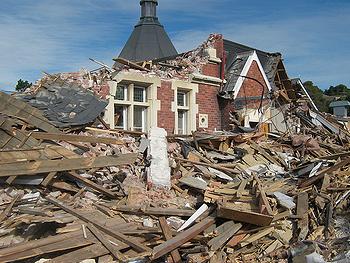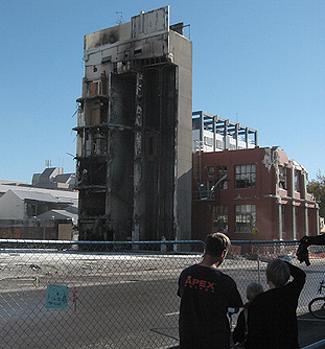New Zealand Forms Alliance to Rebuild Quake-Damaged Christchurch
CHRISTCHURCH, New Zealand, May 3, 2011 (ENS) – A foundational agreement was signed in Christchurch today creating the Infrastructure Rebuild Alliance to repair the city’s infrastructure damaged by the 6.3-magnitude earthquake that struck on February 22 and a series of previous quakes.
Alliancing is an approach to delivering complex large-scale projects where clients, consultants and contractors from several organizations work together to meet quality, cost and time targets.
 |
Earthquake Recovery Minister Gerry Brownlee (Photo by Fulbright NZ) |
“An alliance is the proven best model for this work,” said Canterbury Earthquake Recovery Minister Gerry Brownlee. “It’s the fastest way of completing the job, offers flexibility in a fluid situation, includes local companies, and gets partners to work together toward achieving their common goals.”
Transport Minister Steven Joyce says the newly established Alliance to rebuild Christchurch is a great step forward for the city. “The Alliance will use labour based in Christchurch. This will serve to stimulate the local economy and provide the best response available to the needs of affected residents,” he said.
The state of national emergency declared for Christchurch expired Sunday, leaving the national government with a NZ$8.5 billion commitment to rebuild the damaged metropolis of some 375,000 people, New Zealand’s second largest city.
Government officials are calling the earthquakes the worst natural disaster in New Zealand’s history. While no one was killed in the previous quakes, the February 22 death toll is estimated at 180, with hundreds more injured.
 |
Demolition of a damaged 1886 heritage building in the Christchurch suburb of Cashmere, March 2011. (Photo by Ron Boost) |
The recovery and rebuilding effort will be directed by the newly formed Canterbury Earthquake Recovery Authority, authorized by Parliament under urgency on April 14. CERA took over from the Emergency Operation Centre on Friday.
The Christchurch alliance includes CERA, the New Zealand Transport Agency, the Christchurch City Council, Fulton Hogan, Downer Construction, Fletcher Construction, MacDow New Zealand and City Care.
The alliance will operate under a 120 day interim agreement.
Christchurch Mayor Bob Parker said the interim agreement marks an important milestone. “We have a lot of work to do to rebuild our city, and I am pleased to see the progress we are making. Alliance partnerships are a proven way of delivering the best results on major infrastructure projects and I am heartened to know we will be working with experienced contractors who know our city so we can achieve the best outcome.”
Council General Manager Capital Programme Kevin Locke said city staff worked with New Zealand Transport Agency, NZTA, to determine how best to deliver the large-scale rebuild of city infrastructure and he is convinced that an alliance is the best way forward.
 |
The ruins of the CTV building in Central Christchurch where some 100 people died in the February 22 quake. (Photo by Ron Boost) |
“It has been demonstrated that this way of working brings innovation and value for money to projects,” said Locke. “Where the model has been used by NZTA elsewhere in New Zealand, it has resulted in opportunities for innovation, reduced start-up times and the completion of projects ahead of schedule,” he said. “For example, in Auckland the Manakau Harbour Crossing was delivered nearly 12 months ahead of schedule and under budget.”
CERA will lead the recovery strategy, policy and planning; coordination and planning of infrastructure; all individual building inquiries; cordon management including access schemes for business, temporary and residents; demolitions and debris management; the Cashel Mall Re:Start project; and business communications.
CERA also will be responsible for economic recovery coordination as well as skills and workforce planning.
The Council will be responsible for water and waste issues; roading and traffic management; kerbside collections; water conservation and restrictions, including the state of the city’s waterways which will be shared in conjunction with Environment Canterbury; and a rodent management plan.
Also, the Council will be responsible for earthquake prone building policy; heritage; resource consents; Central Business District business putrescence cleaning; and flood protection.
Mayor Parker said his concern that the central government would insist that the City Council sell its assets to pay for earthquake recovery was put to rest by Earthquake Recovery Minister Brownlee.
 |
Christchurch Mayor Bob Parker (Photo courtesy Office of the Mayor) |
“Brownlee has made it very clear to both the media and to me personally that he has no intention of insisting that the Council sell its assets, including our council companies, to fund the earthquake recovery bill,” said the mayor.
The Council owns land within the four avenues that define the Central Business District. “At some point the Council may consider the transfer of the property to achieve the desired result of rebuilding our city,” the mayor said. “However, any decision would be made by the Council and would not come at the direction of the Government.”
Mayor Parker today invited all Christchurch residents to get involved with recovery planning for the Central City through stakeholder workshops, panel discussions, focus groups and social media events.
“We are holding a Community Expo at the CBS Arena on Saturday 14 May and Sunday 15 May for residents to share their ideas on the redevelopment of the Central City. We need everyone’s ideas if we are to create a Central City where people want to live work and play,” the mayor said.
“The community has until the end of June to share their ideas before the draft Central City Plan is written, and in line with government legislation, is released for formal public consultation. During this phase the public will be asked to comment on the content of the Plan, through submissions and taking part in Council hearings,” Mayor Parker explained. In December, the Central City Plan will be presented to the Canterbury Earthquake Recovery Authority.
 |
Buildings at Manchester and Worcester streets in Christchurch damaged in the September 2010 quake (Photo by Cameron Hodgson) |
The series of earthquakes that damaged Christchurch began on September 4, 2010 and continued with quakes on October 19, November 14, December 26, January 20 and February 4, leading up to the most disastrous quake on February 22 that damaged much of the Central Business District and the 5.3 magnitude aftershock on April 16.
Earthquake Commission has received more than 300,000 claims from the Canterbury earthquakes which began on September 4 and is receiving, on average, around 1,300 new claims daily.
The New Zealand Government will spend about $8.5 billion over the next few years help rebuild Christchurch, Finance Minister Bill English said April 12.
“The earthquakes do not fundamentally change our economic situation or the government’s program,” he said in a speech to the Wellington Employers’ Chamber of Commerce. “They simply make the task of returning to surplus a little more difficult.”
At this stage, the Treasury estimates the direct cost to the government of the two most damaging earthquakes at about $5.5 billion, which will be fully provided for in the budget on May 19, English said.
 |
Finance Minister Bill English (Photo courtesy Government of NZ) |
In addition, the direct cost of meeting residential property damage will be at least $3 billion, making a total direct cost to the government of around $8.5 billion, he said.
On the other side of the ledger, the Treasury had previously estimated that the government’s loss of tax revenue as a result of the earthquakes and lower economic growth could be between $3 billion and $5 billion over the next five years.
“It sounds a lot,” said English. “But New Zealand’s annual GDP is around $200 billion a year; the government spends around $70 billion a year; and it has assets of over $220 billion.”
“Meeting the Government’s share of the immediate earthquake costs will require a quite substantial front loading of Crown debt in the next year or two. That’s because we need to get the rebuild underway quickly and therefore we need the money immediately.”
English said, “The budget will clearly set out the government’s plan to return to surplus, so we can start paying off this debt.”
As the state of emergency was lifted Sunday, Civil Defence Minister John Carter said, “I have been proud to witness the Civil Defence response to this earthquake and to see the great community spirit shown by New Zealanders not only in Canterbury, but around the country and the world,” said Carter. “We are a nation that rallies in times of need.”
Copyright Environment News Service (ENS) 2011. All rights reserved.
